

| Works are in alphabetical order. I have followed the rules established by the museum--that I could photograph (without flash) any works owned by the museum. page 1: sculptural works by anonymous French sculptor, School of Donatello, and Richard Hunt page 2: fabulous painting (with details) by the 18th century woman painter, Adélaïde Labille-Guiard page 3: sculptural works by Sol Lewitt, Paul Manship, and Henry Moore page 4: sculptural works by Juan Muñoz, Hiram Powers, Augustus Saint-Gaudens, and Elihu Vedder Thanks so much to Dorian Goureau who provided me with most of the factual information below; most of the comments are quoted almost directly. | ||
Adélaïde Labille-Guiard (1749-1803)Labille-Guiard specialized in portraiture and was court painter to Louis XV. The sitter here is the king's fourth daughter (1732-1800).
Because Labille-Guiard supported the revolutionaries during the French Revolution, she lost her clientele and was also forced to destroy some of her portraits of royalty. She was talented in depicting textures, as this very large painting clearly demonstrates. It occupies pride of place in one of the Speed Art Museum's galleries. |

| |
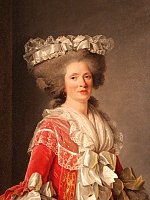
|
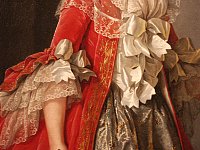
|
|
| According to Dorian Goureau, the blue print on the stool is of a convent that Madame Adelaide was "directing"; it was founded by her mother Queen Marie Leczynska, and after her death, her daughter took care of it. Madame Adelaide was a very devoted Princess. | ||
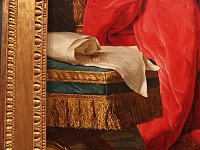
|

|
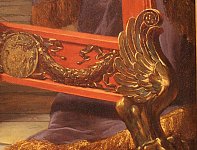
|
| According to Dorian Goureau, the three profile heads on the medallion are from left to right: the Dauphin (1729-1765) brother of Madame Adelaide and son of Louis XV, then Marie Leczinska (1703-1768) mother of Madame Adelaide and wife of Louis XV, and finally the King Louis XV (1710-1774) father of Madame Adelaide. At the bottom of the medallion it says : "leur image est encor le charme de ma vie", which means "their image/picture is still the charm of my life." Madame Adelaide was also the most artistic of Louis XV's eight daughters, and the artist represents her as the author of this medallion/hommage to her late parents and brother. | 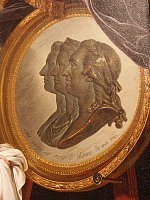
| |
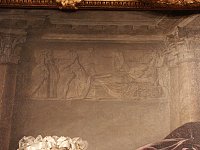
|
According to Dorian Goureau, the bas relief represents the death of Louis XV, on May 10, 1774. He died from "la petite verole" which is smallpox. Madame Adelaide and her little sister Madame Victoire stayed with their father during his sickness, agony and death, despite the advice of the doctors against contagion. On the bas relief we can see Louis XV's corpse laying on the bed (on the right) and on the left we can see Madame Adelaide with Madame Victoire crying in her arms. The other characters must be doctors, nurses, priests, and court people, official people. | |
 Click here to return to index of art historical sites.
Click here to return to index of art historical sites.
 Click here to return to index of artists and architects.
Click here to return to index of artists and architects.
 Click here to return to chronological index.
Click here to return to chronological index.
 Click here to see the home page of Bluffton University.
Click here to see the home page of Bluffton University.
